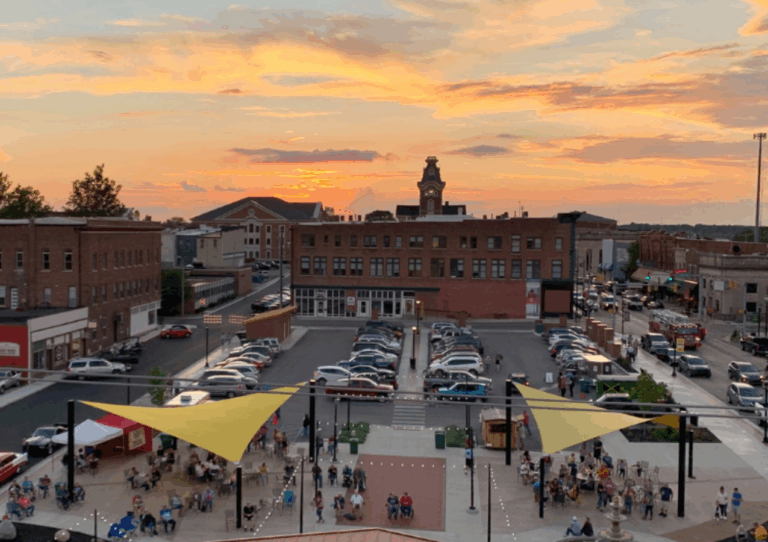Shawnee National Forest: Illinois Garden of the Gods
Disclaimer: Blog posts may contain affiliate links/ads or be sponsored/hosted. If you click on these links, I may earn a small commission. This helps keep the blog running and supports me – at no cost to you. If you have any questions, please read my disclaimer and privacy policy. All opinions on Cornfields & High Heels are my own.
Updated August 2024
Southern Illinois has one of the best-kept secrets in the Midwest: Garden of the Gods Wilderness in the Shawnee National Forest. I hadn’t heard of Garden of the Gods until I saw photos posted on a fellow travel writer’s Instagram page. Not many seemed to know about this amazing Midwest location when asking others if they had ever been. I knew we had to visit!

Most people think of Colorado when they hear “Garden of the Gods.” Colorado is known for its famous National Natural Landmark, Garden of the Gods Park, which shares the same name as this almost equally breath-taking recreation area in Herod, Illinois.
Garden of the Gods Recreation Area has over 3300 acres of wilderness and is located within the Shawnee National Forest. Unique rock formations and cliffs offer scenic, panoramic views that will leave you wondering if you’re still in the Midwest! This area reminds me that the Midwest has WAY more to offer than just flatlands and cornfields (I’m reminded of this countless times!). Hiking, camping, backpacking, and picnicking are welcome here, but you’ll want to be prepared before you go.
The Shawnee Hills Wine Trail ventures through the Shawnee Hills National Park and would be a great addition to your visit!
Garden of the Gods information:
- Free to visit, open 6 am – 10 pm
- Campsites are $10/night for up to 8 people & 2 vehicles. Camping is first-come, first-serve.
- Backpacking overnight parking is allowed.
- Food and beverage containers are not allowed on trails. Pack It In, Pack It Out while on trails.
- Leashed pets are allowed.
- Watch out for poison ivy and venomous snakes.
Hiking at Garden of the Gods Recreation Area
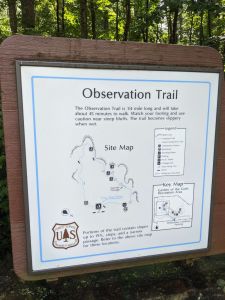
Observation Trail
The Observation Trail is the most popular in the National Forest. It offers the most scenic views and is a short 1/4-mile trail. Plan to take at least 1-2 hours to explore the area. This trail is busiest in April and October. The trail is marked with pavers and is easy for all ages; however, please note that some narrow spaces, uneven pavers, and stairs/paths along the trail may be difficult for those with physical limitations.
On the observation trail, we caught a glimpse of Camel Rock, Anvil Rock, and Mushroom Rock—all beautiful rock formations that can be viewed from the trail and scenic viewpoints. Daring climbers can get better views; this is allowed at their own risk. If you are afraid of heights, stay on the observation trail portion. You will want to watch small children, as some areas don’t have guardrails near the cliffs and can easily be accessed.
If you are up for more hiking, Garden of the Gods has 5.5 miles of interconnecting trails marked by color.
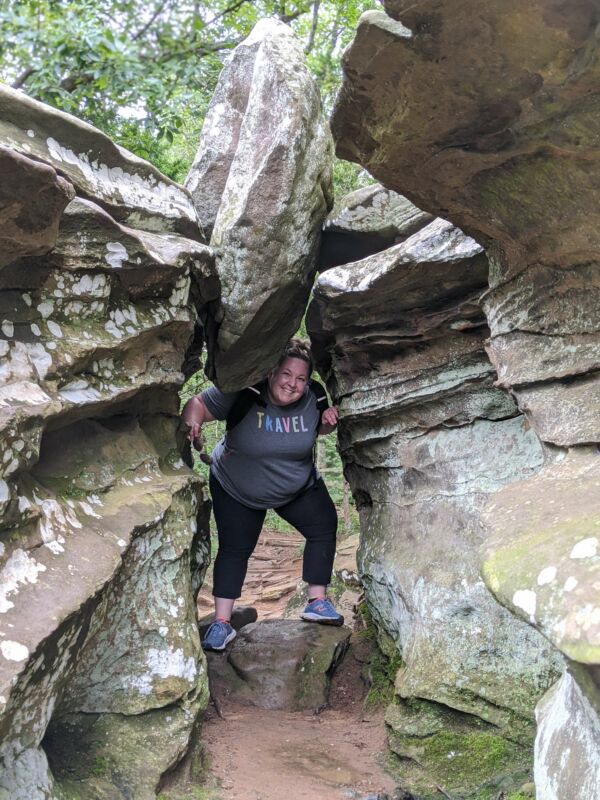
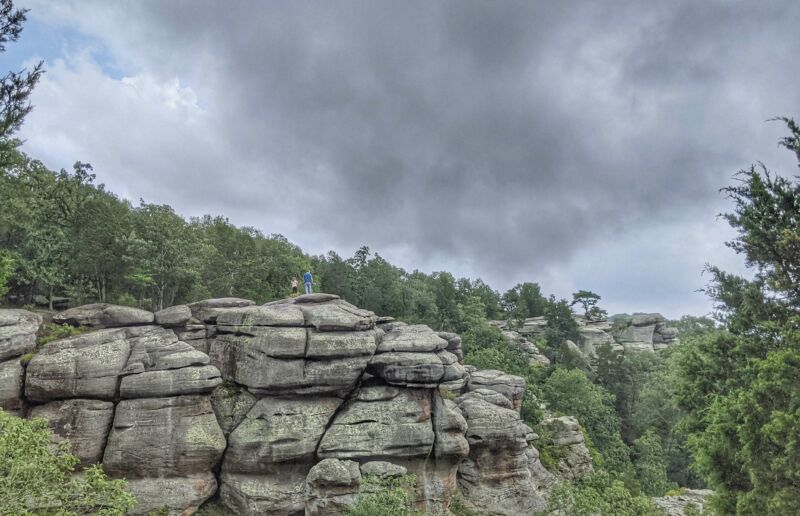
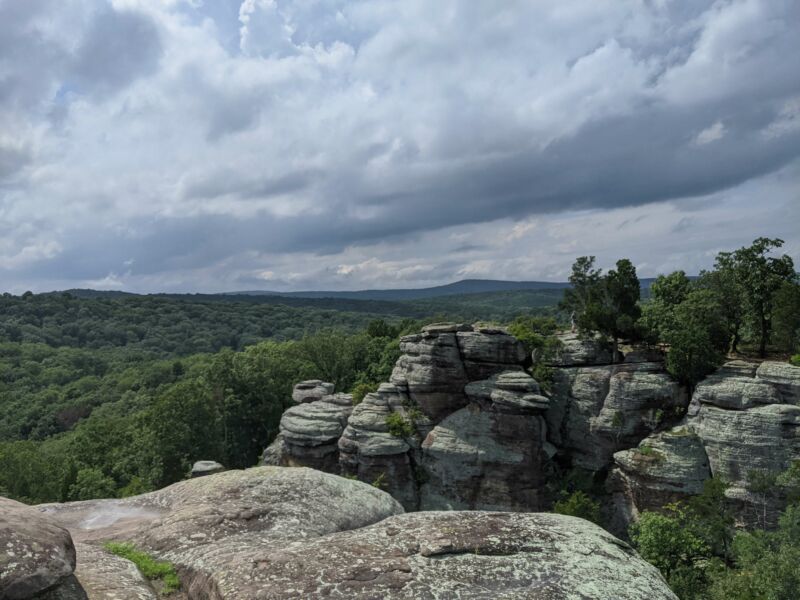
Indian Point Trail
The Indian Point Trail is an easy-to-moderate 2-mile trail that descends the bluff and loops back to the trailhead. For smaller children or those with physical limitations, you can avoid descending to the bluff by staying to the right of the loop (this will shorten your hike to around 1 mile). This trail offers a view of the cliffs and rock formations similar to the Observation Trail. You’ll feel like you are in the middle of the wilderness without the risk of getting lost. Watch out for poison ivy and bugs on this trail.
Garden of the Gods Trail
The Garden of the Gods Trail is a moderate 2-mile non-loop (out and back) trail. This trail is not as scenic as the Indian Point and Observation Trails, but you are rewarded with a pretty valley view at the end. It is also a horse trail that goes farther than the hiking portion, so you’ll want to know where the turn-around spot is.
River To River Trail: Garden of the Gods Wilderness Section
The River To River Trail is most commonly used by backpackers (park in the backpacking parking lot to access it). It’s a winding, intermediate 5.4-mile trail featuring caves/rock shelters, bluffs, and a couple of deeper creek pools. It is suggested for more advanced hikers.
Camping at Garden of the Gods Recreation Area
No reservations are required for camping; sites are available on a first-come, first-serve basis. Campsites are $10 for up to eight people and two vehicles. No electricity or running water is available, these are primitive camping sites.
Tips for visiting:
- Cell phone coverage is spotty (we had no signal during our visit). If you plan to hike, bookmark or print a trail map in advance.
- Vault toilets are available; you’ll want to pack that hand sanitizer and water jug/soap!
- The best times to visit are weekdays, with the exception of April and October (the busiest months). Avoid rainy days, as the trails can get really slick.
- Bring bug spray – you’ll need it!
- Interested in birding? Bring your binoculars because there are over 250 kinds of birds in the area. Other critter sightings include bald eagles, red-tailed hawks, bobcats, armadillos, and red foxes.
- Bigfoot sightings are common here—you can even take a fun tourist photo with the roadside Bigfoot statue!
Other MUST SEE spots in the Shawnee National Forest
Cave-In-Rock State Park
New State Park Rd, Cave-In-Rock, IL
If you don’t do anything else, visit Cave-In-Rock State Park! It’s only 15 minutes south-east of Garden of the Gods and is free to visit. It’s a spectacular state park along the Ohio River. A 55-foot limestone-carved cave faces the river, formed thousands of years ago. You can walk into the cave and take in its surreal natural beauty (great for photo ops, too!).
Plenty of picnic spots overlook the Ohio River, or you can dine at the Cave-In-Rock Restaurant and Lodge (which also has accommodations). The park also offers hiking trails and playgrounds.
Dixon Springs State Park
982 IL-146, Golconda, IL
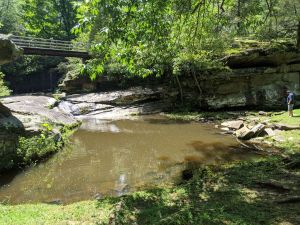
This Illinois state park is built on gigantic sandstone, making it a great site for canyon and waterfall exploring! During the 19th century, Dixon Springs was a health spa that attracted visitors from all over to its seven mineral-enriched springs. You can still spot some of the springs today. Trails, picnic areas, camping, and a swimming pool with a bathhouse and waterslide are open to visitors (the pool is open during the summer months).
Check out my Garden of the Gods YouTube video!
Nearby places to visit:
Pin it for later!



